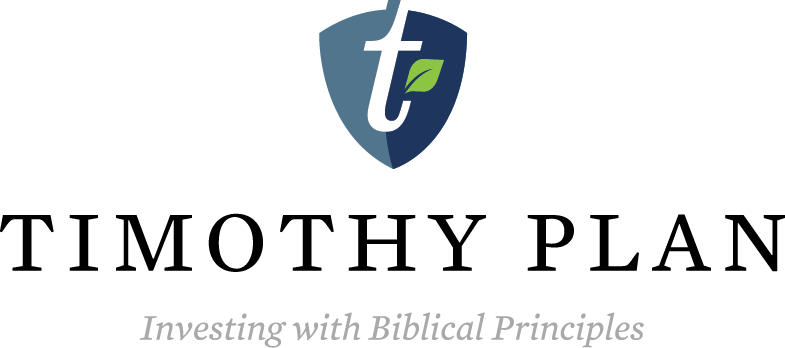Large/Mid Growth 2Q20
September 15, 2020
Recent Posts
- A Businessman Who Really Did Give it All Over to GodSeptember 28, 2022
- A 'Screwtape' Approach to Keeping Christians from Biblically Responsible InvestingSeptember 21, 2022
- Both Inflation and Inaction Are UnbiblicalSeptember 14, 2022
- Misunderstood in the NeighborhoodAugust 18, 2022
- Billy Graham was the inspiration for the new BiblegraphAugust 9, 2022
- A Businessman Who Really Did Give it All Over to God
Categories

Investing involves risk, including the potential loss of principal.
Before investing, carefully consider the fund’s investment objectives, risks, charges, and expenses of the investment company. This and other important information can be found in the fund’s prospectus. To obtain a copy, visit TIMOTHYPLAN.COM or call 800.846.7526. Read each prospectus carefully before investing.
Because the Timothy Plan Funds do not invest in excluded securities, the Funds may be riskier than other funds that invest in a broader array of securities. There are risks when a fund limits its investments to particular sized companies, and all companies are subject to market risk. The Fund recently experienced significant negative short-term performance due to market volatility associated with the Covid-19 pandemic.
MUTUAL FUND INVESTOR
To read more about our mutual funds, please click this link to access fund information, including the prospectus, fact sheets, performance, and holdings for each fund.A prospectus is available from the Fund or your financial professional that contains more complete, important information. Please read it carefully before investing. Mutual Funds distributed by Timothy Partners, Ltd. Member FINRA.
HEADQUARTERS: 1055 Maitland Center Commons, Maitland, FL
(800) 846-7526 | Send an email | View our mapMUTUAL FUND SHAREHOLDER SERVICES: c/o Ultimus Fund Solutions, Post Office Box 541150, Omaha, NE 68154-1150
(800) 662-0201 | Account AccessETF INVESTOR
To read more about our ETFs, please click this link to access fund information, including fact sheets, performance and holdings for each fund. A prospectus is available from the Fund or your financial professional that contains more complete, important information. Please read it carefully before investing. ETFs distributed by Foreside Fund Services, LLC, Member FINRA. Timothy Partners, Ltd. is not affiliated with Foreside Fund Services, LLC.
ETF SHAREHOLDER SERVICES: Contact your financial advisor for information regarding your account.






Macroeconomic Update
From the depth of despair in late March throughout the second quarter the U.S. economy began its recovery. The aggregate data however masks the unevenness of that recovery. Industries with underlying demand that had curtailed operations as a precautionary measure against the COVID-19 virus, such as manufacturing and construction, had very different rebound dynamics than those industries that had demand evaporate as a result of the virus, such as travel, leisure, and entertainment. As of July 2, 2020, the Atlanta Federal Reserve’s GDPNow™ estimates Q2 2020 growth at negative 35.2% percent, the largest quarterly decline in economic growth in US history. The severe late-March collapse did not reverse course until mid-May as certain states began easing “stay-at-home” restrictions. The Institute for Supply Management Manufacturing index (June 2020 Manufacturing ISM®) which had troughed at 41.5 in April finally made its way back into expansionary territory with the June release at 52.6. Similarly, the Non-Manufacturing (services) index (June 2020 Non-Manufacturing ISM®)snapped back from a low of 41.8 in April to 57.1 in June. The New Orders and Business Activity sub-components led the move into expansionary territory but, as with the Manufacturing Index, the Employment sub-component remained in contraction. It should be noted that both of these surveys are conducted during the middle of the month, so the June readings do not incorporate the virus resurgence in some of the larger re-opening states.
Although the supply side of the economy showed an unprecedented decline from February to April, the demand side of the economy contracted even more severely. In April alone, more than 20 million people filed for initial unemployment claims. That was on top of the more than 13 million fi ling claims in February and March of this year. The fact that average hourly earnings spiked nearly 8% in April despite the decline in employment indicated that lower wage workers bore the brunt of the job losses. As states began to loosen stay-at-home restrictions in May and June, employment began to recover with over 7 million jobs added in those two months. The unemployment rate remains (as of July, 2020) at an elevated level above 11% though and the underemployment rate is at 18%. As important as the loss of jobs, personal spending also fell precipitously, down nearly 14% in April alone before partially rebounding in May on state re-openings. The fact that the incidence of COVID-19 has resurged and restrictions have been instituted or reinstituted puts the employment and spending improvements in jeopardy over the coming months.
This recession is proving to be confounding, as its effects are highly concentrated among certain industries. The food service, transportation, and hotel industries have been bludgeoned by COVID-19, and the job loss has been dramatic in these industries. However, the average median income for employees in those sectors are less than half of the U.S. median income; as a result, aggregate personal spending hasn’t been impacted dramatically. Actually, several industries such as the homebuilding and automobiles has posted favorable sales results over the past two months. The big caveat to this recovery is obviously the nascent spike of cases in 25 states since quarter end, with particularly concerning data emerging from Florida, Texas, Arizona and California.
Q2 2020 Review
Contributors
NVIDIA Corp. (4.5%; up 44%) designs and manufactures computer graphics processors, chipsets, and related multimedia software. It is remarkable that this stock was a top performer (+12%) in Q1, in the market’s massive sell-off , and now it is again a top performer in the “rebound” quarter (Q2). Very few stocks did well in both market environments. It speaks to the view that NVIDIA has both defensive-growth characteristics but also often has a high beta to up markets. The company had another compelling quarter, with 39% year-over-year revenue growth buoyed by staggering 80% growth in datacenters. And this was even with some COVID-19-related supply chain disruption.
Synopsys, Inc. (2.7%; up 51%) provides software products and consulting services in the electronic design automation (EDA) industry, with semiconductor companies as the primary client base. This company is a secular grower and the global leader in a duopoly market structure. They are increasing operating margins at a pace beyond what the Street was expecting, and this is allowing them to produce steady 14-15% EPS growth.
Detractors
Honeywell International (3.2%; up 8.8%) is a diversified industrial company; segments include Aerospace, Home and Building Technologies, Performance Materials, and Safety and Productivity Solutions. The Industrials sector underperformed the Russell 1000 Growth in Q2 and, additionally, Honeywell underperformed Industrials. COVID-related demand fall-off in several end markets impacted the company’s Q1 (reported in April), and organic revenue fell 4% (and they guided to a greater contraction in the following quarter). A silver lining was 140 bps of margin expansion, driven by productivity and cost controls. We view this company as a core holding longer term, due to its diversified end markets, operational execution, and strong management.
Costco Wholesale (2.8%; up 6.6%) engages in the operation of membership warehouses. The company – and stock – did extremely well in Q1, as a beneficiary of lock-downs and for being a purveyor of essential goods in bulk form. Q2 was a relative give-back of sorts (though the stock was still up); retailers and consumer outlets that are more exposed to the reopening of the economy were the winners in the second quarter. April’s -4.7% sales comp was the first negative read in quite some time, but May and June rebounded with +5.4% and +11.5% comps, respectively – both exceeding expectations.
Market Outlook
Perhaps more so than at virtually any other time in the past – other than last quarter!– visibility is extremely limited. The market sell-off of 34% in five weeks was stunning, but equally stunning has been its recovery. The Nasdaq has set new all-time high records, and the Russell 1000 Growth is now up almost 10% YTD (through 6/30). In hindsight, the Federal Reserve credit facilities and lending programs have proven to be,extremely effective, particularly in reassuring investors that the Fed will be very creative and aggressive in stimulating the economy and supporting both the equity and credit markets. As it relates to our expectations of the rest of 2020, it all circles back to how long COVID-19 will impact the economy (yes, that is the exact sentence used in the Q1 commentary). However, we have become more optimistic. The pace and initial data for the vaccine programs under development are astonishingly positive, and we now believe that vaccines will be available under Emergency Use Authorization in the fourth quarter, with wider availability in the spring of 2021. Thankfully, the structure of the virus is well defined, allowing vaccine producers to develop effective vaccines in record time. The only caveat is that it’s quite possible that this vaccine will have efficacy rates of only 50-70%, not 99% as seen with other vaccines. Therefore, it will be necessary for a large percentage of the population to be vaccinated in order to reach herd immunity.
We added some weight in Technology, such that we are only about 4% below the benchmark weight, and this is even as the benchmark sector weight went higher as a result of the Russell annual rebalance. Consumer Discretionary is the other area where we are looking for new investments.
Please feel free to call or email us with any feedback or questions about the portfolio.
Manager views expressed herein were current as of the date indicated above and are subject to change. It should not be assumed that recommendations made in the future will be profitable or will equal the performance of the securities in this commentary. A copy of the calculation methodology and the full list of recommendations made in the preceding year is available upon request. The performance data quoted represents past performance and does not guarantee future results. Performance returns quoted are gross of fees which were calculated on a time weighted basis and do not give effect to investment advisory fees, which would reduce such returns. Please see Chartwell’s Form ADV, Part II for a complete description of investment advisory fees. The following statement demonstrates the compound effect advisory fees have on investment returns: For example, if a portfolio’s annual rate of return is 15% for 5 years and the annual advisory fee for a client is 100 basis points or 1.00%, the gross cumulative 5 year return would be 101.1% and the five year return net of fees would be 92.5%. Actual fees charged to portfolios may be different due to various conditions including account size, calculation method and frequency, and the presence of a performance or incentive fee. The deduction of performance and incentive based fees will have similar, yet often larger, impacts to performance and account values than standard management fees. To receive a complete list and description of Chartwell Investment Partners’ composites, performance attribution for all securities, and/or a presentation that adheres to the GIPS® standards, please contact Lynette Treible by phone (610)407-4870, email [email protected], or by mail to 1205 Westlakes Drive, Suite 100, Berwyn, PA 19312.